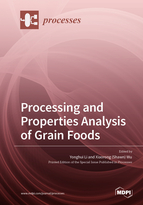Processing and Properties Analysis of Grain Foods
A special issue of Processes (ISSN 2227-9717). This special issue belongs to the section "Food Process Engineering".
Deadline for manuscript submissions: closed (15 April 2022) | Viewed by 43106
Special Issue Editors
Interests: bakery science and chemistry; functional grain foods; grain protein chemistry, modification, and functionality; grain-derived bioactive compounds and peptides
Special Issues, Collections and Topics in MDPI journals
Interests: basic and application research on product quality and new uses related with hard winter wheat and grain sorghum including NIR sorting; milling; physical and chemical analysis of raw materials and end
Special Issue Information
Dear Colleagues,
We are writing to invite you to submit a review or research paper to the upcoming Special Issue—“Processing and Property Analysis of Grain Foods”—in the journal Processes. Foods from grains and grain-derived ingredients are among the most important energy and nutrient source for humans. Cereals (e.g., wheat, rice, corn) have been the conventional food materials, while interest is growing in utilizing pseudocereals (e.g., buckwheat, quinoa, amaranth), pulses (e.g., dry peas, chickpea, dry beans), oilseeds (soybean, peanut, hempseed), and other grains for the development of various foods and food ingredients. Grain and food processing are key steps to converting raw grains to functional ingredients and producing palatable and nutritious end-products. Examples of grain-related processes include—but are not limited to—malting, drying, milling, fractionation, hydration, fermentation, extrusion, cooking, baking, frying, steaming, freezing, etc. Various physical and chemical changes and interactions are expected during these processes, which further affect the nutritional, texture, sensory, and many other quality properties of the products. Methods, protocols, and equipment have been developed to process, monitor, and control the processing parameters in order to achieve the desired end-product quality or functionality. This Special Issue focuses on grain processing innovations and the effect of both conventional and innovative grain processes on the properties of grain-derived ingredients, intermediates, and end products.
Dr. Yonghui Li
Dr. Shawn/Xiaorong Wu
Guest Editors
Manuscript Submission Information
Manuscripts should be submitted online at www.mdpi.com by registering and logging in to this website. Once you are registered, click here to go to the submission form. Manuscripts can be submitted until the deadline. All submissions that pass pre-check are peer-reviewed. Accepted papers will be published continuously in the journal (as soon as accepted) and will be listed together on the special issue website. Research articles, review articles as well as short communications are invited. For planned papers, a title and short abstract (about 100 words) can be sent to the Editorial Office for announcement on this website.
Submitted manuscripts should not have been published previously, nor be under consideration for publication elsewhere (except conference proceedings papers). All manuscripts are thoroughly refereed through a single-blind peer-review process. A guide for authors and other relevant information for submission of manuscripts is available on the Instructions for Authors page. Processes is an international peer-reviewed open access monthly journal published by MDPI.
Please visit the Instructions for Authors page before submitting a manuscript. The Article Processing Charge (APC) for publication in this open access journal is 2400 CHF (Swiss Francs). Submitted papers should be well formatted and use good English. Authors may use MDPI's English editing service prior to publication or during author revisions.
Keywords
- processing technology
- cereals
- pulses
- oilseeds
- ancient grains
- food ingredients
- milling
- thermal processing
- baking
- fermentation
- food properties
- functionality
- nutrition
- sensory
- texture







